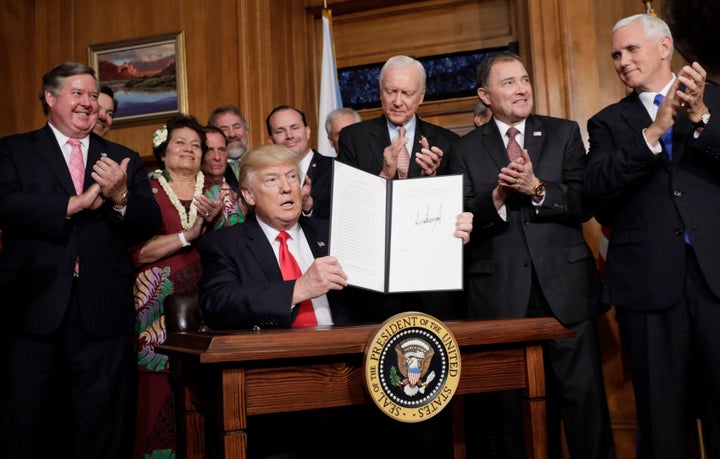WASHINGTON — Nothing gives U.S. presidents the authority to abolish, shrink or otherwise weaken national monuments, four legal scholars have concluded in a new analysis.
However timely and significant, the findings are likely to be ignored by President Donald Trump, who appears set on trying to rescind monument status on sites such as the 1.35 million-acre Bears Ears National Monument in Utah, or at least shrink them. If he does, the administration will almost certainly be challenged in court.
In their paper, three law professors from the University of Colorado, UCLA, and the University of California, Berkeley, and a faculty research fellow at UCLA conclude that Congress, not the president, has sole legal power to rescind or weaken protections for monuments designated under the Antiquities Act of 1906.
Twenty-seven of America’s national monuments, spanning more than 11 million acres of land and about 760 million acres of ocean, are threatened by a pair of executive orders signed by Trump last month. One order tasks the Interior Department with reviewing all federal monuments 100,000 acres or larger that were established or expanded after Jan. 1, 1996. The other instructs the Department of Commerce to review all marine sanctuaries and monuments designated or expanded within the last 10 years.
Sean Hecht, a co-author of the paper and co-executive director of the Emmett Institute on Climate Change and the Environment at UCLA School of Law, told HuffPost the Antiquities Act — signed by President Theodore Roosevelt more than a century ago — is “unusual” in that, unlike other statutes of that era, it did not grant presidents the authority to withdraw or revoke protections. The point of the law is to allow for presidents to set aside areas for preservation — not take away protections put in place by their predecessors.
Furthering their argument, Hecht and the others point to a 1938 opinion by then-Attorney General Homer Cummings and the Federal Land Policy and Management Act of 1976, which conclude the law does not allow for a president to reverse a monument.
“We’re confident that our reading of the law is correct,” Hecht told HuffPost.

The Antiquities Act authorizes the president to “declare by public proclamation historic landmarks, historic and prehistoric structures, and other objects of historic or scientific interest that are situated upon the lands owned or controlled by the Government of the United States to be national monuments.” Sixteen presidents have used the law to designate 157 monuments.
No president has ever tried to revoke a monument designation.
Trump’s orders call for the pair of federal agencies to “review” recent designations and offer recommendations. What Trump and Interior Secretary Ryan Zinke have made clear, however, is that they are pushing for much more.
In his remarks last month, Trump said he’s looking to end “another egregious abuse of federal power,” put “states back in charge” and open up now-protected areas to “tremendously positive things.” The law, he added, “does not give the federal government unlimited power to lock up millions of acres of land and water, and it’s time we ended this abusive practice.”
Zinke said last month that the law has “become a tool of political advocacy rather than public interest” and that past administrations have abused it by ignoring its language specifying monuments be “confined to the smallest area compatible with proper care and management.”
“Despite this clear directive, ‘smallest area’ has too often become the exception rather than the rule,” Zinke said last month.
In an attempt to make his point, Zinke noted that America’s first monument, Devils Tower in Wyoming, designated by Roosevelt in 1906, was less than 1,200 acres. “Yet, in recent years, we’ve seen monuments span tens of millions of acres,” Zinke said, a clear reference to marine monument designations and expansions by presidents George W. Bush and Barack Obama.
What Zinke fails to mention is that the size of several early monuments rival the designations of recent years. In 1908, for example, two years after the Antiquities Act became law, Roosevelt — of whom Zinke is an “unapologetic admirer and disciple” — designated more than 800,000 acres of Grand Canyon as a national monument. (Only a few Obama-era land monuments are larger.)
Republican presidents Calvin Coolidge and Herbert Hoover also designated monuments over a million acres. Coolidge designated Alaska’s Glacier Bay in 1925, and Hoover set aside California’s Death Valley in 1937.
Hecht said he sees what the Trump administration is doing — and saying — as “wholly political.” A look at history, he said, clearly shows that presidents, both Republicans and Democrats, have used the law to much the same scope and scale.
Ultimately, Hecht expects the Trump administration will move to abolish or shrink monuments, which will inevitably lead to a battle in the courts. If that happens, Hecht said, he would expect a court to agree with the legal position he and the others outlined in their paper.
“For more than 100 years, Presidents from Teddy Roosevelt to Barack Obama have used the Antiquities Act to protect our historical, scientific, and cultural heritage, often at the very moment when these resources were at risk of being exploited,” the authors write. “That is the enduring legacy of this extraordinary law. And it remains our best hope for preserving our public land resources well into the future.”
The paper has been accepted for publication by Virginia Law Review Online.
As part of its review, the Interior Department kicked off a public comment period last week. Comments relating to Bears Ears are due by May 26, while comments related to all other monuments must be submitted by July 10. As of Thursday, more than 45,000 comments had been submitted.
Read the full research paper here.
This article has been updated to reflect that three authors are full professors.

